Bold Visions for the Embarcadero Emerge at Public Design Workshops
6:26 PM PST on November 26, 2014
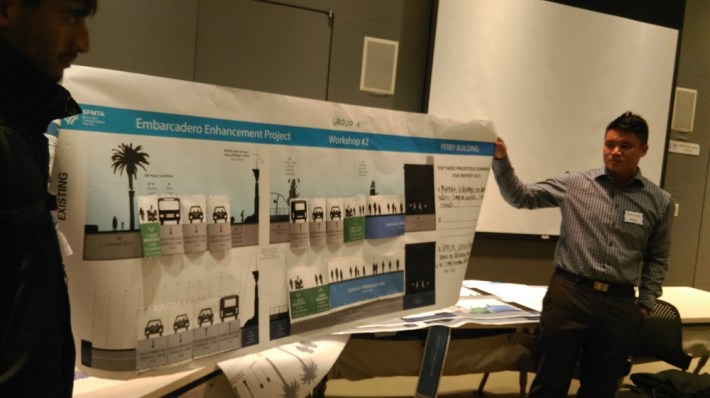
Ever since the Embarcadero was uncovered from beneath a freeway more than two decades ago, San Franciscans' appetite for a more people-friendly waterfront only seems to have grown.
At a series of recent public design workshops this month, groups of attendees were asked to put together a display of how they'd re-allocate street space on the Embarcadero. The main idea was to figure out how to provide a protected bikeway, so that riders of all ages can enjoy the popular waterfront without having to mix it up with either motor vehicles or crowds of pedestrians on the shared sidewalk.
At one of the workshops, two groups suggested that half of the roadway, on the waterfront side, be dedicated primarily to walking and biking, even if it includes a shared-space zone where delivery drivers can move through slowly for loading. Finding a design that allows deliveries to safely co-exist with the bikeway seems to have been the main challenge since the SFMTA launched its redesign process in July.
Overall, the idea of re-thinking the Embarcadero as a street with less room for cars and more for walking and biking has been popular. Most of the groups at one workshop said all car parking should be eliminated from the street. Hundreds of parking spaces sit empty in nearby lots and garages -- with more coming.
Even Mary McGarvey, an SF tour bus driver, espoused the idea of devoting the entire waterfront side of the roadway -- which currently includes three traffic lanes and one car parking lane -- to foot and bike traffic. The Embarcadero's median streetcar tracks would then provide a buffer from motor vehicles.
McGarvey said she's personally seen the successes of similar waterfront reclamations in cities in Germany, Austria, and northern Europe.
"Once they're in, people love it," she said. "I've worked in tourism for practically 20 years. Everybody would love to have a big, wide-open space where they feel safe from traffic and from bicyclists hitting them."
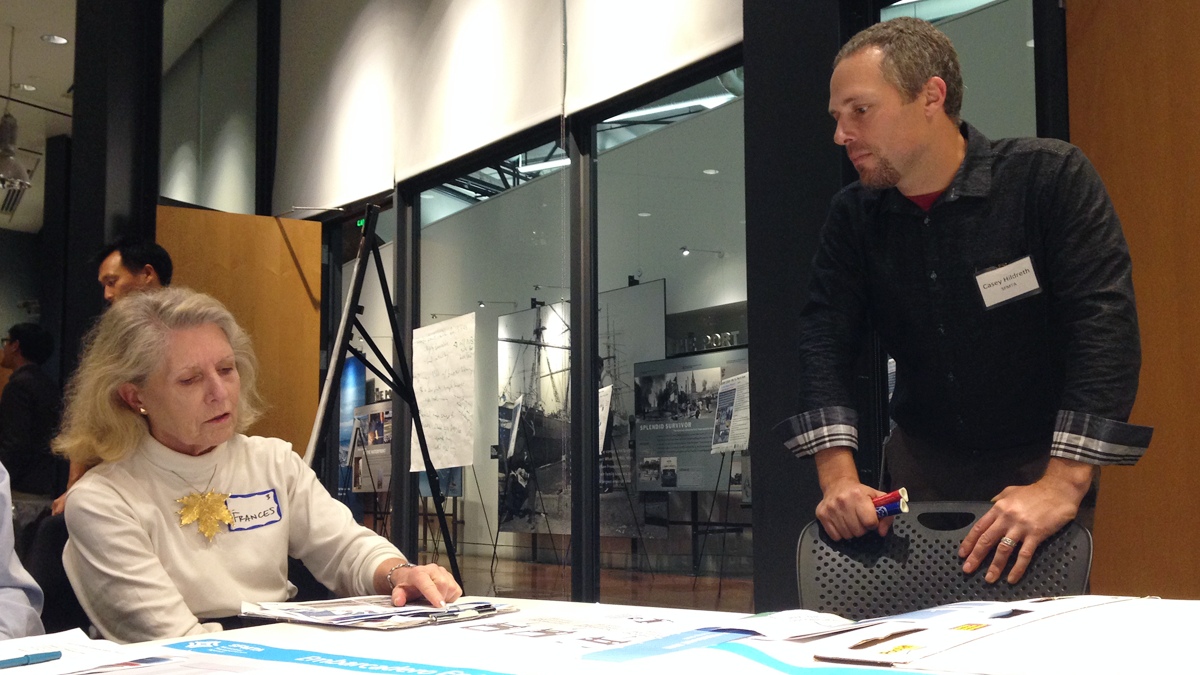
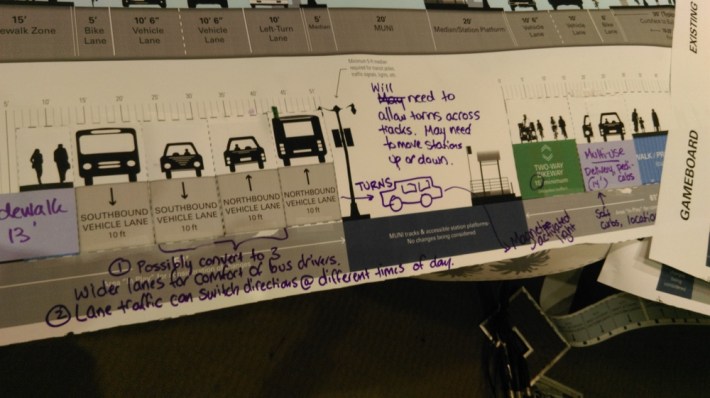
"Let's face it -- our city's officially an anti-car city," she added. The popular measures to get cars off of Market Street, which are set to expand next year, make the message "clear: cars are out -- goodbye. And cars comply: They can take Mission, leave the car at home, whatever. These cars can do the same. This is not a place for cars."
Patrick Golier, the SFMTA's manager for the Embarcadero project, said it's too early to say whether such bold visions could become reality. The SFMTA has held three workshops, each focusing on "pinch point" segments where the width of the Embarcadero is narrowest, he said.
"What makes it exceptionally complicated on the Embarcadero is that the land uses and demands change from block to block. So a proposal may work for one block, but not two blocks north or south of that," said Golier.
Still, "we're looking for big-picture ideas," he said. Planners will develop designs based on the "themes" that workshop attendees presented, and they'll also be vetted with merchants and other groups. "Not all users are represented here at the workshop, but at this point," all ideas are on the table, said Golier.
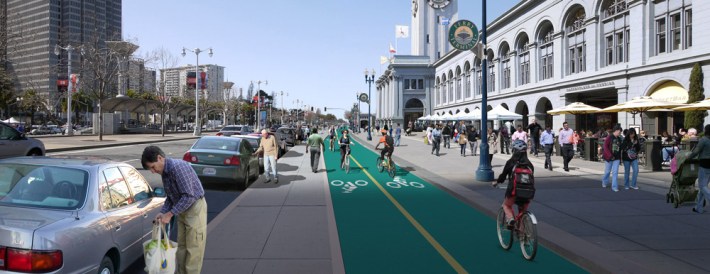
There were a handful of attendees who wanted to see little change to the status quo. Rick Hall, who identified himself as a driver, said he sees "a lot of potential for the [design] process to not be fair and open," and that the project is symbolic of "San Francisco's war on cars, that I have awakened to."
Hall said he sees a "built-in bias" in the design process towards bikes and people, exemplified by the size of the paper traffic lane templates workshop participants used. Participants could place 10-foot-wide traffic lanes on their design board -- not wide enough for buses -- while the bikeway could be eight to 12 feet, he said.
Of course, the Embarcadero and most SF streets' have car-centered layouts that were hardly designed under a "fair and open process" in the 20th century. And even proposed designs that devote the waterfront half to walking and biking still included 40 feet of width for traffic lanes.
"The question is, what's the priority on the waterfront?," said Livable City Executive Director Tom Radulovich, who participated in the workshops. "Is it visitors going to places like the Ferry Building? People walking and cycling up and down? Or is it having the Embarcadero be a big waterfront highway?"
"We probably made a mistake as a city, building this giant highway along the waterfront, and I think it's time we take it back."
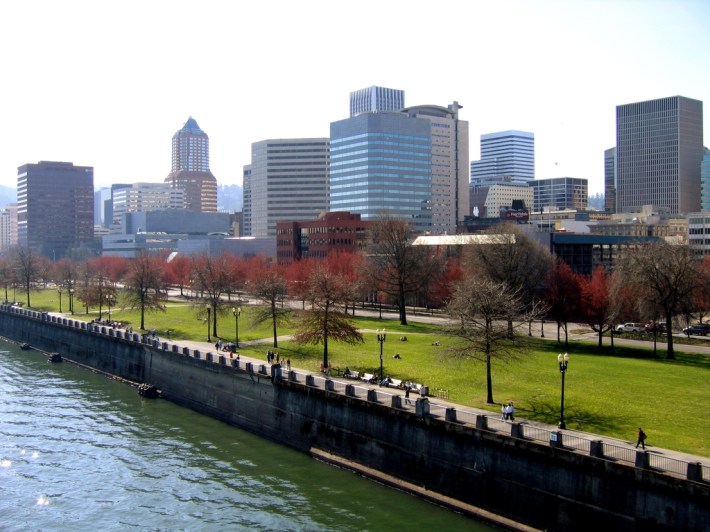
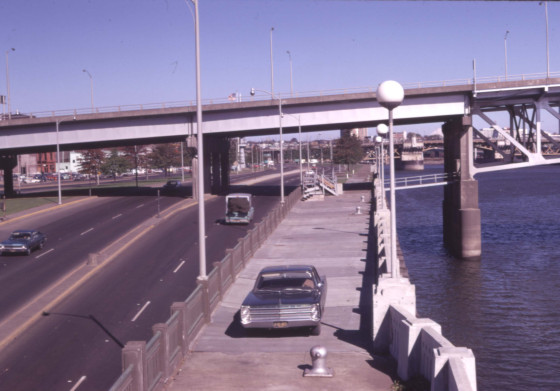
Stay in touch
Sign up for our free newsletter
More from Streetsblog San Francisco
Commentary: There is Zero Ambiguity to the West Portal Tragedy
What happened in West Portal was entirely predictable and preventable. The city must now close Ulloa to through traffic and make sure it can never happen again
Independent Safety Advocates Beef up the Wiggle
Signs and soft-hit posts installed by advocates make the Wiggle bike route calmer and safer for cyclists and pedestrians




